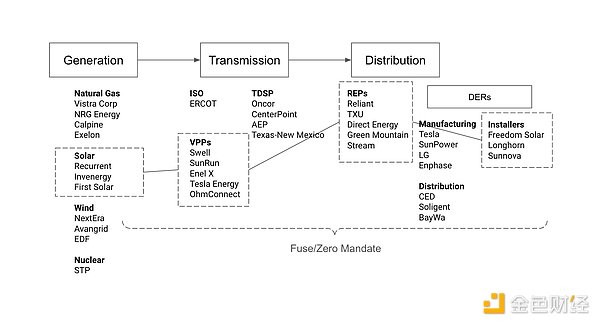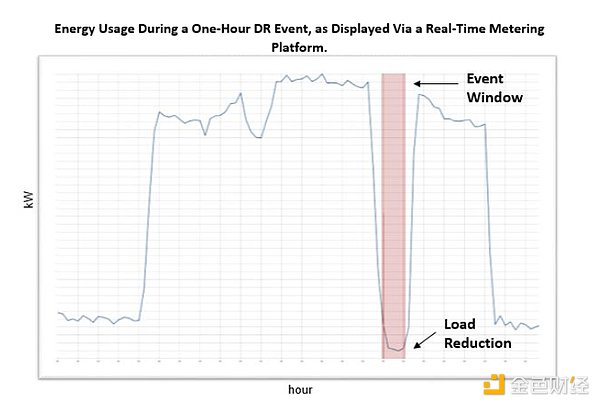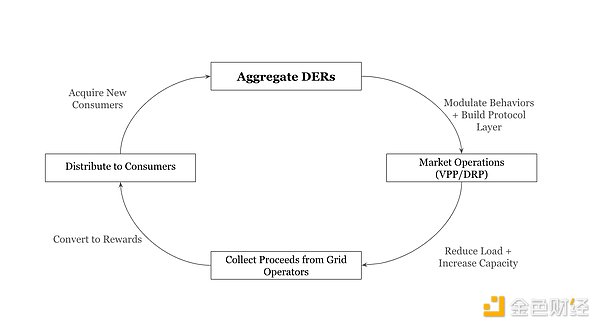Original title: The Great Energy Coordination Problem
Author: Shayon Sengupta, Multicoin Capital Investment Partner and Tushar Jain, Co-founder of Multicoin Capital; Translated by: 0xxz@黄金财经
Today, we are proud to announce the completion of a $12 million investment in Fuse. Fuse is a core contributor to Project Zero, a renewable energy DePIN that aims to solve huge energy coordination problems.
Fuse is a full-stack renewable energy company founded by Alan Zhang and Charles Orr, both early employees of Revolut and key figures in Revolut's early development. Alan and Charles have been looking to solve the energy crisis since 2022. Over the past few years, Fuse has built a modern technology-based energy company: building powerful data and engineering systems with the goal of serving customers at a better cost and efficiency than today's utility giants.
Currently, Fuse operates utility-scale solar and wind farms, distributed energy resource (DER) installations, and serves tens of thousands of homes in the UK as a regulated electricity supplier.
But that’s not enough. To meet the world’s growing energy needs, we need to add 4,000 terawatt-hours of new generation each year over the next decade—roughly equivalent to building the entire U.S. electric grid from scratch every year. An additional $4 trillion in investment in grid modernization, storage, and transmission infrastructure will be needed each year through 2030—more than the annual GDP of Germany or Japan.
The problem gets even worse when you add in the complexity of geopolitics: thousands of jurisdictions, mountains of red tape and regulators, and a multitude of market players, each with their own incentives and constraints. We face a big energy problem over the next decade. We need a new approach, and that’s where Project Zero comes in.
Project Zero is a renewable energy DePIN that aims to accelerate the expansion of renewable energy and the utilization of decentralized energy resources (DER) by rewarding network participants for shifting demand to renewable energy times, supporting the utilization of e-mobility, and generating new generation through solar panels or batteries.
Energy generation and coordination is one of the biggest opportunities of our lifetime, and this cannot be solved by traditional railroads or structures alone. While running Fuse, Alan and Charles realized that crypto-backed capital formation mechanisms would be essential for future development. Project Zero does exactly that: an incentive layer acts as a foundation for coordination of the most fragmented parts of the energy value chain.
Fragmented Energy System
The dominant trend in the energy industry is horizontal aggregation within specific segments (such as generation, transmission, or retail) rather than vertical integration across the value chain.
Installers like Trinity like to focus on the deployment of distributed energy resources (DER) but do not engage in direct energy retail business. Conversely, retail energy providers like NRG Energy typically do not offer DER installation services unless these services are bundled with traditional generation. Vistra Group — A large U.S. power generator with a diversified asset base including natural gas, coal, nuclear, and solar, operating multiple retail brands such as TXU Energy, Ambit Energy, and Dynegy, suffers from underutilization in coordinating supply and demand across its generation portfolio. These entities operate largely independently, limiting their ability to achieve the greatest returns from operations at scale.
These inefficiencies are particularly acute. Inconsistent data formats and incomplete consumption telemetry hamper grid operators’ real-time monitoring and demand forecasting. Fragmented permitting frameworks across jurisdictions hinder economies of scale in renewable resource installation and service operations. Information silos hamper retailers from proper pricing and risk management.
Fuse approaches the retail energy supply chain from first principles and intentionally operates at every layer to minimize efficiency losses between each step in the generation to distribution lifecycle. They are laser-focused on their mission to deliver affordable, clean energy at scale and work hard to achieve that.
 In the near future, this means addressing two specific problems:
In the near future, this means addressing two specific problems:
1. Consumer Transformation Inertia – How do we encourage people around the world to change their consumption patterns to more effectively balance grid loads as part of demand response programs and to further adopt residential renewable products and distributed energy resources (i.e., electric vehicle chargers, batteries, solar inverters, heat pumps, smart thermostats)?
2. The Retail Energy Distribution Standards Problem – How do we bridge the disjointed processes between retail energy providers, grid operators, virtual power plants, and DER installation service providers that have historically made it difficult to generate economies of scale through geographic expansion of the retail energy business?
Project Zero complements Fuse’s vertical integration strategy by providing an incentive layer for consumers to seize opportunities to transform their energy consumption and build new renewable energy capacity.
Aggregating Energy Assets at Scale
Fuse wants to empower homeowners to be conscious and active in their energy choices.
The planet needs active and responsive consumers of resources, not those who view energy use as a charge on their monthly bill. Fuse is accelerating this transition by building delightful consumer energy experiences while mediating the allocation of zero-emission project incentives to influence consumption patterns and encourage the installation of new capacity.
As an energy retailer with direct relationships with customers, Fuse is structurally well-positioned to capture and distribute the value created by solving some of the most difficult coordination problems in the space: facilitating demand response programs (DRPs), operating VPPs, building low-latency metering systems, and leading new interoperable data standards.
Demand Response Programs (DRP)
Fuse can capture underutilized potentialDRPs dynamically respond to grid conditions by regulating energy consumption at the edge. Although DRPs can reduce peak electricity demand by 20%, the vast majority of eligible households around the world do not participate in these programs. This means that millions of kilowatt-hours of electricity can be shifted or reduced during peak times, significantly reducing operating costs.
When electricity demand is high or supply is low, Project Zero can issue token incentives (not just discounts) to owners of energy resources within the network (smart appliances, water heaters, thermostats, CHP systems, solar panels, batteries) to reduce or shift their consumption. This balancing ability allows Fuse to stabilize the grid, aligning supply and demand at critical moments.

Source: NYC DCAS
These consumption shifts can drive demand reductions per household, resulting in benefits of up to $3,000 per MWh. At scale, a portion of the benefits of these programs can be returned to consumers in the form of token rewards that can be used to lower energy bills or redeemed directly for instant rewards.
As more households opt in to dynamic consumption shifts through Project Zero protocol incentives, Fuse can bid in large numbers in DRP events. This enables Fuse to provide greater, more predictable load shedding or shifting capacity, for which we believe utilities and grid operators are willing to pay a premium.
Virtual Power Plants (VPP)
DER installers (solar panels, battery storage, electric vehicles, smart appliances) are often unable to work with energy retailers to provide homeowners with the optimal system size and configuration. This not only results in low market penetration of much-needed distributed energy resources, but these systems are often completely disconnected from the overall grid.
In Fuse’s vision of a world, Zero incentivizes households to build new renewable energy capacity and ensures that net new resources are utilized as efficiently as possible. This enables Fuse to act as its own VPP, combining all DERs into a single, flexible entity that can provide valuable grid services.
When the grid faces high demand or supply shortages, Fuse instructs DERs to increase energy production or release stored power (for example, solar and battery storage systems in a VPP can quickly discharge or absorb power to help maintain grid frequency within a narrow range, or smart thermostats and water heaters can be temporarily shut down or adjusted to provide demand-side response).
As a virtual power plant (VPP), Fuse participates in wholesale energy markets, aggregating its DER footprint in local markets to bid on a larger and more predictable scale than pure energy retailers. Fuse can also provide services such as voltage support, which are critical to grid stability. These services can generate significant revenue, typically up to $100,000 per megawatt per year.

By improving the reliability of these services through advanced metering and rich analytics, we expect Fuse to be able to secure more favorable contracts and higher payments from grid operators. The goal is to have the benefits of these open market operations flow back to users who contribute assets to the network.
Advanced Metering and Real-Time Data
A long-standing problem for energy producers and retailers is the lack of real-time data on power plant outages, demand fluctuations, and other factors that directly affect energy production. Without this data, pricing energy correctly and profitably becomes a major challenge.
Fuse bridges this gap by leveraging its direct relationships with consumers to collect ad hoc, minute-by-minute data. This real-time information is fed into Fuse’s advanced billing engine to inform all pricing decisions, which we believe will enable the company to participate in wholesale markets with greater profitability. This means cheaper, cleaner energy in every market served by the network.
With its expanding customer footprint and control over the grid it serves, we believe Fuse is better positioned than most to profitably navigate the energy markets and ultimately help others.
Building an Open Protocol
At scale, Project Zero is an open platform that provides visibility into all energy production and consumption resources, permissionlessly accessible to any party in the energy value chain.
As Fuse accumulates more and more energy assets at the edge, Project Zero begins to serve as a strong, trusted, neutral protocol layer. This is the right way to build a 21st century global energy system: connecting accessible energy resources through consistent, interoperable data standards that anyone can build products and services on top of.
The Path to Energy Abundance
Fuse’s advantage over the giants in the space is that it cleverly removes the cogs from the machine through cryptographic coordination primitives. This approach should more effectively engage users and involve them in the closed-loop generation and distribution process, making Fuse a new kind of global energy retailer: one that not only trades electricity more profitably through asymmetric data and system improvements, but also incentivizes the adoption of renewable energy and ultimately rewards customers at every step of the process.
Alan and Charles have deep operational expertise in regulated, consumer-facing environments. The Fuse team is a group of customer-centric builders and market operators focused on solving the most pressing energy problems of our time.
As the first core contributor to Project Zero, Fuse will build it into an open, shared platform that brings us closer to cheap, unmetered energy. For more information, visit www.zero2050.com.
 JinseFinance
JinseFinance
 JinseFinance
JinseFinance JinseFinance
JinseFinance JinseFinance
JinseFinance JinseFinance
JinseFinance JinseFinance
JinseFinance JinseFinance
JinseFinance JinseFinance
JinseFinance Edmund
Edmund Cointelegraph
Cointelegraph Cointelegraph
Cointelegraph